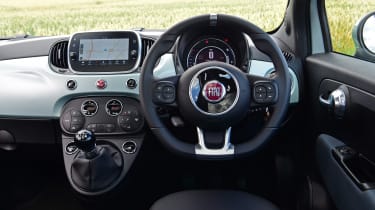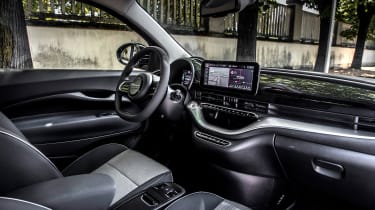Fiat 500: old vs new
The new ‘Mk3’ Fiat 500 is only available as an electric car - how does it compare to the old model?
The Fiat 500 is almost 65 years old, so it may come as a surprise that the brand-new version is only the third-generation model. The first was built from 1957-1975 and the second model has been on sale for the last 13 years without major updates, so it’s clear that Fiat doesn’t like to change the recipe too much.
That was true, until now; the new car might look like a 2020 reinterpretation of the original but pop its petite bonnet open and you won’t find a conventional engine. That’s because the third version of the 500 will only be sold as an electric car, rivalling the similarly retro-styled Honda e and MINI Electric, as well as the SEAT Mii Electric. Many manufacturers are discontinuing their city cars at the moment but the electric powertrain should futureproof the new 500. Who knows - it might enjoy a similarly long production run to its predecessors.
The previous Fiat 500 is still going to be sold alongside the shiny new one, badged as the ‘classic’ model. A new mild-hybrid 1.0-litre petrol engine means it also has some semblance of electrification, and 53mpg should be possible. The ‘old’ Fiat 500 will be cheaper than the new one but if you’re not sure which you should pick, this is the guide for you.
Styling
Fiat’s unashamedly retro design has done plenty of favours for the old 500 because it doesn’t look any older than when it was launched way back in 2007. In that time, there have been a lot of new paint colours, alloy wheel options and special-edition versions (far too many to count) to try to keep the 500 fresh, and 2016 saw the introduction of more modern front and rear lights.
The new model looks similar to the last one but it’s taller, longer and wider. Park the two side-by-side and the size difference becomes clearer because the new car sits an inch higher than the old one. There are modern-looking split LED headlights and a blanked-out grille because there’s no requirement for cooling ducts.
Interior and technology
Glossy buttons and a fetching strip of body-coloured dashboard trim help give the outgoing 500 a classic feel and, like the exterior, it doesn’t feel like a product of the mid-noughties. The same basic design of the dash and seats hasn’t changed much but most new cars get a seven-inch touchscreen instead of a basic radio unit. It enables you to connect your phone but it’s far from the best touchscreen around - although that’s to be expected given the car’s reasonably low price. To show its (mild) eco credentials, the launch edition for the new mild-hybrid engine features seats made from recycled plastic bottles.
The new 500’s interior is quite a departure from the old one and it’s clearly a product of recent times. Sadly, it looks a little more generic than the last car’s cabin but the new wealth of technology onboard is welcome. Rather than using a screen from an existing model, the new car debuts Fiat’s new UConnect 5 infotainment system, featuring a ‘floating’ 10.25-inch touchscreen with slick graphics and the very latest in smartphone connectivity. An accompanying app lets you preheat the cabin before you climb in, while front sensors mean it can have safety tech like traffic sign recognition.
The diminutive Fiat 500 is never going to be the most spacious car but the new one gets the same meagre 185-litre boot as its predecessor, despite being noticeably larger. There’s a lot of space in the front, and rear-seat passengers have a little extra room but will still feel snug.
Electric vs petrol
The Fiat 500 ‘classic’ was equipped with a 68bhp 1.2-litre engine for most of its life, which was willing but ultimately short of power, and not particularly economical either. In 2010 it was joined by a much more modern ‘TwinAir’ engine that’s just 0.9 litres in size and only has two cylinders. This fizzy, fun engine is worth considering, although you’re unlikely to get anywhere near the 52mpg Fiat claims (35mpg is more realistic). Now, it’s been superseded by a 69bhp 1.0-litre mild-hybrid engine, which is available across the entire range and should be capable of getting near to the official 53mpg figure.
There’s no need to visit a petrol station in the new car. The electric Fiat 500 can be fully recharged from a home wallbox in around six hours, while recharging to 80% from a public fast-charger takes 35 minutes. Depending on the model you choose, you’ll be able to travel up to 115 or 199 miles between charges, or slightly more if you just drive it around town. The Fiat 500 EV is so much quicker from 0-62mph than the petrol one, while recharging at home costs only a few pounds and VED (road tax) is free.
Prices and specs
The last-generation model is soldiering on for a couple more years to give buyers the option of a cheaper way into 500 ownership. Pop starts at just over £13,000 at the time of writing but lacks the touchscreen, Bluetooth, air con and even split-folding rear seats. Lounge trim adds all these plus heated mirrors and parking sensors. There are a couple of special editions, as has always been the way with the 500, while sat nav and dual-zone climate control are among the well-priced options.
A ‘La Prima’ launch edition ushered in the new electric 500, with LED headlights and the bigger battery, but it’s expensive at £26,995 after the plug-in car grant. Three core trim levels - Action, Passion and Icon - have now joined it, and Action starts at a more reasonable £19,995 but comes with the smaller battery. It comes with parking sensors, alloy wheels and push-button start. Passion adds a seven-inch touchscreen with Apple CarPlay and Android Auto, while Icon gets the headline 10-inch version.
Like the last car, the new 500 will be available as a hatchback and as a convertible, while a ‘3+1’ model with a tiny rear door is in the works but isn’t yet confirmed for the UK.
Verdict
The cheapest new 500 is around £2,000 more than the most expensive old model but the lower running costs of the electric version help with the overall cost of ownership. Electric power is perfect for a city car because of its instant delivery and, importantly, because it doesn’t release any harmful emissions into the immediate area. Fiat enjoyed success with relatively costly special editions of the last-gen 500, so we don’t think the higher price of the electric model will be too much of a sticking point for many buyers. The futuristic Fiat 500 electric wins this test.
Read our old vs new comparison of the Hyundai i10, or find lots of great deals on used Fiat 500s on BuyaCar.
Recommended

New Subaru Trailseeker revealed as rugged electric SUV with 375bhp

New Subaru Solterra brings more range, power and polish
Most Popular
Tips & advice

Car dashboard warning lights: what does each symbol mean?

Electric car charging stations: public networks, charger types, apps and maps













